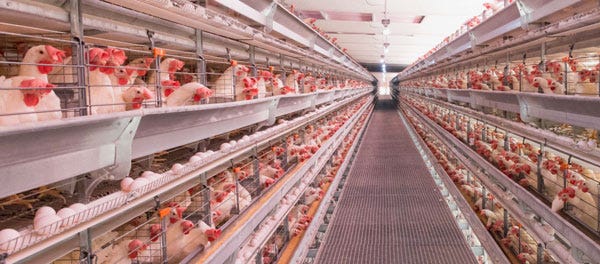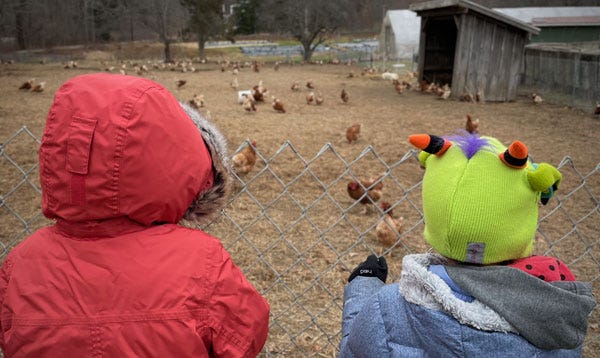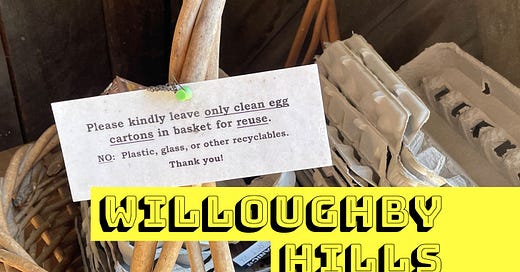Let's Talk About Egg Cartons
Questioning whether economies of scale are as efficient as they claim
Welcome to another edition of Willoughby Hills!
This newsletter explores topics like history, culture, work, urbanism, transportation, travel, agriculture, self-sufficiency, and more.
If you enjoy what you’re reading, please consider a free subscribtion to receive emails every Wednesday and Sunday plus podcast episodes every two weeks. There are also paid options, which unlock even more features.
In business classes, we are taught about the wonders of economies of scale. There are supposedly great efficiencies in consolidating operations, standardizing production, and working within big systems.
I’m beginning to question if that’s always the case.
I look at egg production, for example. According to United Egg Producers, two thirds of the eggs for sale in supermarkets in this country are produced in tight quarters. The laying hens live in small cages stacked in long indoor barns. There is a feed tray in front of them where manufactured pellets are delivered and a separate place where manure and eggs are removed.

Farms like these can house thousands of birds. With the average cost of a dozen eggs around $2.14 per dozen (as of November, 2023), it could be argued that these operations are producing eggs incredibly efficiently.
But I don’t know that the cost of a dozen eggs should be the only way that we judge this model of production and I believe that there is a lot of waste that is not considered when we discuss the efficiency of a conventional egg farm.
Iowa produces more eggs than any state, and the top five egg producing states (Iowa, Ohio, Indiana, Pennsylvania, and Texas, respectively) represent about half of the egg production in the U.S., which means there’s a fair amount of trucking to get eggs to local supermarkets.
There’s also the challenge of manure at conventional egg farms. When properly managed, chicken manure can be an excellent natural fertilizer, and many farmers are able to sell their manure to other farmers to use as a soil additive. But if mismanaged, manure can easily pile up, polluting waterways and contributing to greenhouse gas pollution.
I’ve written about many of these issues before, but today, I want to look at an issue that is seemingly smaller but that shows the efficiency that can come from small farms: the packaging of eggs.

For several years now, we’ve sourced all of our eggs from local farms that all follow similar procedures for raising pastured eggs. During warmer weather, the chickens live in rolling henhouses that are surrounded by temporary fencing. They are free to roam in grass pastures, foraging for bugs (while also being fed supplementary feed). They drop their manure where they are, and it immediately goes to work fertilizing the grass and making a stronger pasture. At some farms, cows then follow behind, eating the newly fertilized grass as part of their life cycle.
The chickens on our local farms live outdoors and never see the inside of a cage. It’s the type of life you imagine when singing “Old MacDonald Had a Farm” or is reminiscent of Cinderella feeding the chickens (and mice) in the Disney movie.
But again, this isn’t about the eggs or the chickens, but about the packaging. Nearly every farm we purchase from sells their eggs in cardboard containers AND they accept cardboard containers back for reuse.
Eggs are a delicate food, so they do require some kind of protection to get safely home and to be stored in the refrigerator. But most egg containers are completely single use and disposable. Even if they are added to a cardboard recycling bin, there are transportation costs to get the egg carton to a recycler, plus there are energy costs associated with turning old cardboard into new cardboard. This also doesn’t account for eggs sold in plastic or styrofoam containers.
By returning egg cartons for reuse, those transportation costs and recycling costs are gone. The carton simply gets stamped with a new expiration date and filled with a fresh dozen of eggs. This also leads to lower costs for small farmers, as they don’t need to constantly purchase new cartons.
Perhaps my favorite part of reusing egg cartons though is that most farmers accept an eclectic mix of cartons, not just those which originally came from their farm. This means that the egg refrigerator at these local farms is always an assortment of containers bearing different logos.
I’ve handed in old egg cartons for reuse, bought a fresh dozen eggs in the same container a few days later, and then returned that carton when it’s empty. I wouldn’t be surprised if the same cartons were reused five or six times by my local farm.
When an egg carton gets too soiled for reuse (say an egg unexpectedly cracks inside of it), because it is made of cardboard, the egg carton can then be composted rather than discarded.
The eggs I buy range from $7 to 8.50 per dozen, depending on the farm, so it is a significant bump up from conventional supermarket eggs. From a purely economic standpoint where the bottom line is the only consideration, my local farmer is terribly inefficient at producing eggs and I am significantly overpaying for something that could be produced for 1/4 the price in an industrial system.
But as I started out this piece, I am skeptical that price alone captures the true cost of an economy of scale.
Egg carton reuse can really only happen at a small operation, where the eggs are laid, boxed, and sold under the same roof (or nearby). The logistics of collecting used cartons for reuse at scale immediately becomes a challenge: does the local supermarket handle that or does it happen at another collection facility? How are those cartons returned to the egg distributor and then to the individual egg farms? How are the products differentiated once they return to a supermarket in packaging other than their original one?
These problems don’t exist at a small farm, where a basket near the door collects old egg cartons, they are brought to the room where eggs are washed and boxed, and because the eggs for sale are all identical, the packaging is less relevant.
Buying eggs from a local farm also significantly reduces the transportation costs of hauling feed to a farm, hauling manure away, and hauling eggs around the country. Because of the size of these operations, the cost to haul a dozen eggs is fairly negligible in dollars (it’s probably measured in pennies or fractions of pennies), but the pollution and simple waste of all of that trucking isn’t accounted for in any monetary sense.
For anybody who has tasted a farm fresh pastured egg versus a conventionally raised supermarket egg, there’s a noticeably better quality to the flavor. There’s also evidence that pastured eggs are more nutritious. Pastured eggs have double the amount of Vitamin E and omega 3 fatty acids, plus a healthier ratio of omega 6 to omega 3 fatty acids.
We live in a world where efficiency is rated solely on the basis of cost to the end consumer, but I am starting to wonder if there’s a better way to measure the true efficiency of an operation. It seems to me that, even if the cost is higher in dollars, the efficiency of reusing manure on site, not transporting eggs across state lines, and reusing egg cartons is the more efficient use of resources. All of this without discussing the ethical and practical questions of animal health and wellbeing, which is a topic for another day.
What do you think? Should the bottom line be the only way we measure what it means to be efficient? How can we start to account for other costs in the calculus of what we purchase? Leave your thoughts in the comments- I love reading what you’re thinking about!
Thanks for reading Willoughby Hills! Subscribe for free to receive new posts and support my work.
Related Reading
If you’ve missed past issues of this newsletter, they are available to read here.







Heath, Happy New Year, and thanks for another great post. I got my economics degree over 40 years ago, and even then we were discussing "true costs" to society which are never taken into account. It's extremely complicated, but the primary problem is that so many people don't even want to acknowledge "hidden costs."